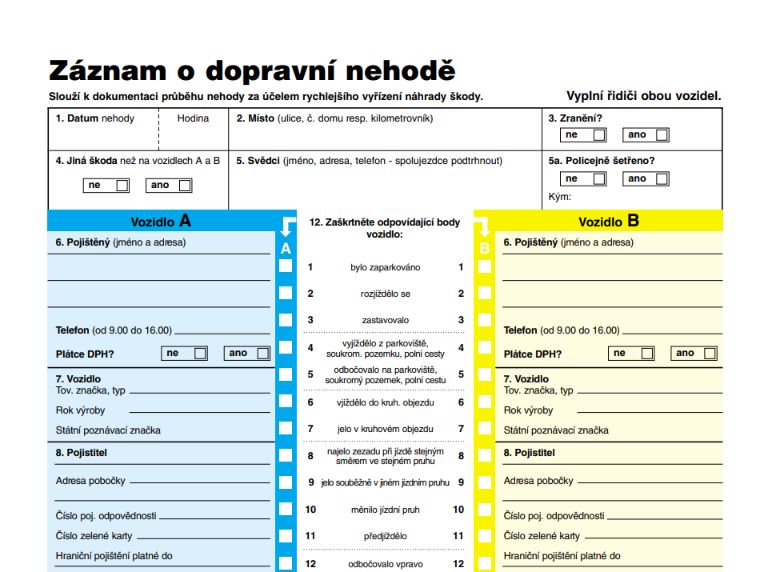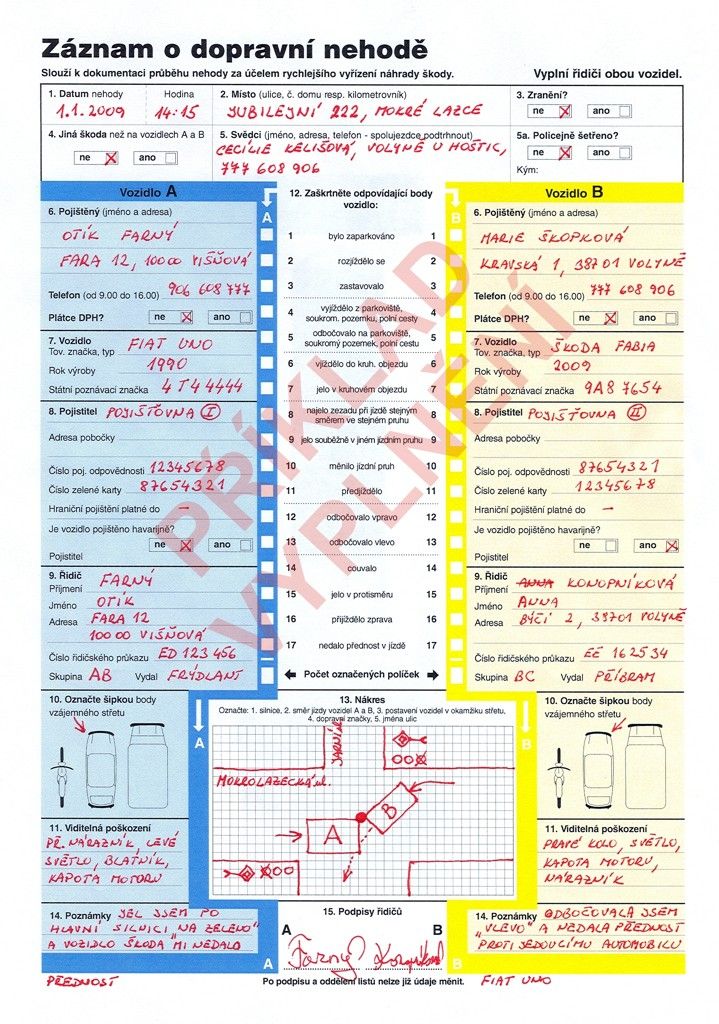Drivin' in Czechia
All you need to drive smart in the Czech Republic
Drivin' in Czechia
All you need to drive smart in the Czech Republic

Traffic Accident Report is a form every driver would rather never use. Yet, unfortunately, traffic accidents do happen, and when they do, this document is indispensable. Below you’ll find a simple guide on how to fill in the Traffic Accident Report correctly. We’ll share a few useful tips:

In the “Date” box, specify as precisely as possible the date and exact time the accident occurred, e.g. 11 February 2025, 18:43.
In the “Place” box describe the accident location in detail. If the crash happened in a town, enter the street name and the number of the nearest house. On a motorway or country road, state the road number and the kilometre of the section; you can read it from a kilometer marker placed alongside Czech motorways and higher-class roads. GPS coordinates from a mobile phone are also acceptable, or a clear verbal description such as: “D5 motorway, direction Prague, near Beroun exit.”
Tick whether anyone was injured or whether property damage occurred to other vehicles or roadside objects (e.g. a street lamp). In that case, the Czech Police must be called to the scene.
Give the fullest possible details of any witnesses. They are helpful if the directly involved parties describe the accident differently. List their name and contact details (phone or email) and, if possible, permanent address. Feel free to mark passengers in a special way (asterisk, underline).
Enter the full name and permanent address of the owner of each vehicle for which compulsory third-party liability insurance has been concluded (A for the first car, B for the second). Add contact details such as phone number or email.
Write the make and exact model of the vehicle involved. You can copy these from the registration certificate. The country of registration will be “CZ” unless the vehicle has foreign plates. If a trailer was being towed, complete the “Trailer” field as well.
This is the insurance company with which each participant has liability coverage. Ideally give the branch address, too. Copy the policy number from the insurance certificate or the green card. If a participant has casco (comprehensive) insurance, mention it here.
Enter information on both drivers: full name, date of birth, permanent address, contact details, plus driving-licence number with its categories and validity. You have the right to ask the other driver to produce ID and licence for verification. If the driver’s data differ from the policyholder, it simply means someone else was driving the owner’s car.
On the vehicle diagram, use an arrow to indicate exactly where the vehicles collided. Choose the relevant sketch (motorcycle, car, lorry).
Briefly describe the damage to the vehicles, e.g. “damaged front bumper on Vehicle A; broken right rear light on Vehicle B.”
Mark all applicable circumstances with a cross and strike out the rest. Indicate whether a vehicle was stationary, moving off, stopping, entering a roundabout, overtaking, turning, etc. Then state how many boxes you ticked for each vehicle.
Describe the accident in more detail using a drawing. Sketch the road layout, show the direction of travel with arrows and the position of vehicles at impact. Add road numbers, street names, traffic signs or signals and indicate main versus minor roads where relevant.
If you feel further information could help resolve the claim, add it under “Notes”. Here you can detail the damage or specify a repair shop where the surveyor may inspect the vehicle.
You may also attach additional documents. Insurers will certainly require photographs of the scene and the visible damage; mention the attachment in the Notes, date it and have both drivers sign it.
Finally, both drivers sign the document. The signature does not constitute acceptance of liability; it merely confirms the identity of the signatories and the information recorded.
You don’t need to buy the form. A sample is usually supplied by your insurer when you take out motor insurance. It’s also available at branch offices or can be downloaded online (e.g. from the Czech Ministry of Transport). Note that downloadable versions are not carbonless copy forms, so you must fill out three separate sheets – for the insurer, for yourself and for the other driver. Print several copies in case you make a mistake.
Currently no binding legal regulation requires drivers to carry a template in the vehicle, nor does it prescribe its format. In theory you could write the report on any piece of paper – even lunch-wrap. However, the template is clearer and guides participants to include all statutory particulars. Abroad it helps that the form is identical across the EU.
If both drivers have a standard form, don’t worry whose to use. One set suffices for two vehicles; three vehicles need two sets. Ensure each participant keeps a copy to avoid later disputes. If copies are lacking, the report should stay with the damaged party; the other may photograph it.
Write legibly. On a carbonless copy form, press firmly so data transfer to the copies. You may request the other driver’s licence and ID to record correct data. Be careful not to mix up Vehicle A and Vehicle B. After both parties sign, nothing may be added or altered. Send the report to your insurer without delay; they will contact you for further details.
Under Czech Road Traffic Act 361/2000 Sb., if police attendance is not mandatory, the participants must draw up and sign a Joint Traffic Accident Report and promptly deliver it to their insurers. Police must be called if damage to any vehicle exceeds CZK 200,000 (EUR 8,120), if anyone is injured or killed, or if third-party property is damaged. Call the police as well if you cannot restore traffic flow, if a participant refuses to complete the report, or if there is disagreement over fault.
These are the key tips for filling in the Traffic Accident Report. If you still feel uncertain, call your insurer’s assistance hotline – the operator will guide you.